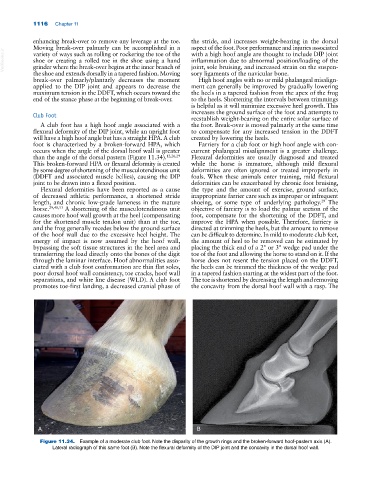Page 1150 - Adams and Stashak's Lameness in Horses, 7th Edition
P. 1150
1116 Chapter 11
enhancing break‐over to remove any leverage at the toe. the stride, and increases weight‐bearing in the dorsal
Moving break‐over palmarly can be accomplished in a aspect of the foot. Poor performance and injuries associated
VetBooks.ir shoe or creating a rolled toe in the shoe using a hand inflammation due to abnormal position/loading of the
with a high hoof angle are thought to include DIP joint
variety of ways such as rolling or rockering the toe of the
joint, sole bruising, and increased strain on the suspen
grinder where the break‐over begins at the inner branch of
the shoe and extends dorsally in a tapered fashion. Moving sory ligaments of the navicular bone.
break‐over palmarly/plantarly decreases the moment High hoof angles with no or mild phalangeal misalign
applied to the DIP joint and appears to decrease the ment can generally be improved by gradually lowering
maximum tension in the DDFT, which occurs toward the the heels in a tapered fashion from the apex of the frog
end of the stance phase at the beginning of break‐over. to the heels. Shortening the intervals between trimmings
is helpful as it will minimize excessive heel growth. This
increases the ground surface of the foot and attempts to
Club Foot
reestablish weight‐bearing on the entire solar surface of
A club foot has a high hoof angle associated with a the foot. Break‐over is moved palmarly at the same time
flexural deformity of the DIP joint, while an upright foot to compensate for any increased tension in the DDFT
will have a high hoof angle but has a straight HPA. A club created by lowering the heels.
foot is characterized by a broken‐forward HPA, which Farriery for a club foot or high hoof angle with con
occurs when the angle of the dorsal hoof wall is greater current phalangeal misalignment is a greater challenge.
than the angle of the dorsal pastern (Figure 11.34). 12,26,29 Flexural deformities are usually diagnosed and treated
This broken‐forward HPA or flexural deformity is created while the horse is immature, although mild flexural
by some degree of shortening of the musculotendinous unit deformities are often ignored or treated improperly in
(DDFT and associated muscle bellies), causing the DIP foals. When these animals enter training, mild flexural
joint to be drawn into a flexed position. deformities can be exacerbated by chronic foot bruising,
Flexural deformities have been reported as a cause the type and the amount of exercise, ground surface,
of decreased athletic performance, a shortened stride inappropriate farrier care such as improper or infrequent
29
length, and chronic low‐grade lameness in the mature shoeing, or some type of underlying pathology. The
horse. 29,48,53 A shortening of the musculotendinous unit objective of farriery is to load the palmar section of the
causes more hoof wall growth at the heel (compensating foot, compensate for the shortening of the DDFT, and
for the shortened muscle tendon unit) than at the toe, improve the HPA when possible. Therefore, farriery is
and the frog generally recedes below the ground surface directed at trimming the heels, but the amount to remove
of the hoof wall due to the excessive heel height. The can be difficult to determine. In mild to moderate club feet,
energy of impact is now assumed by the hoof wall, the amount of heel to be removed can be estimated by
bypassing the soft tissue structures in the heel area and placing the thick end of a 2° or 3° wedge pad under the
transferring the load directly onto the bones of the digit toe of the foot and allowing the horse to stand on it. If the
through the laminar interface. Hoof abnormalities asso horse does not resent the tension placed on the DDFT,
ciated with a club foot conformation are thin flat soles, the heels can be trimmed the thickness of the wedge pad
poor dorsal hoof wall consistency, toe cracks, hoof wall in a tapered fashion starting at the widest part of the foot.
separations, and white line disease (WLD). A club foot The toe is shortened by decreasing the length and removing
promotes toe‐first landing, a decreased cranial phase of the concavity from the dorsal hoof wall with a rasp. The
A B
Figure 11.34. Example of a moderate club foot. Note the disparity of the growth rings and the broken‐forward hoof‐pastern axis (A).
Lateral radiograph of this same foot (B). Note the flexural deformity of the DIP joint and the concavity in the dorsal hoof wall.

